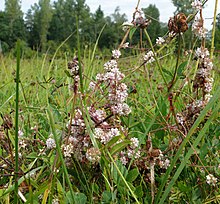Quendel silk
| Quendel silk | ||||||||||||
|---|---|---|---|---|---|---|---|---|---|---|---|---|

Quendel silk ( Cuscuta epithymum ) |
||||||||||||
| Systematics | ||||||||||||
|
||||||||||||
| Scientific name | ||||||||||||
| Cuscuta epithymum | ||||||||||||
| ( L. ) L. |
The Quendel silk ( Cuscuta epithymum ) is a full parasites of the genus silk ( Cuscuta ) in the family of wind plants (Convolvulaceae).
description
Vegetative characteristics
The Quendel silk plant is an annual herbaceous plant and becomes 20 to 60 centimeters long. The thin, branched, reddish stems of the Quendel silk have hardly any visible remains of leaves.
Generative characteristics
The flowering period extends from July to September. The short-stalked to sessile flowers are arranged in inconspicuous pink-colored flower clusters. The flower crowns are bell-shaped. The capsule fruit contains numerous seeds.
The number of chromosomes is 2n = 14.

ecology
As with all Cuscuta species, the seedling looks for a host plant by rotating the thread-like stem in circular movements until it finds a suitable plant to wind up on. In the case of Quendel silk, this is done with a left-hand winding. With its suction appendages ( haustoria ), the silk penetrates the conduction tissue ( phloem ) of the host plant and removes the nutrient solution necessary for growth.
Occurrence
Quendel silk is found in Europe from western England and southern Norway , Latvia and Estonia to the south in northern Spain , Italy (including Sicily ) and Greece . Outside of Europe it is native to North Africa and from Turkey to China. It is a neophyte in Australia, New Zealand, North and South America . The clover silk occurs in Central Europe in societies of the association Violion caninae, Genistion pilosae, also of the sub-association Sarothamnenion, less often in the Mesobromion. It is a character species of the class of the grass grass and dwarf shrub heaths (Nardo-Callunetea). In the Allgäu Alps, the subspecies Cuscuta epithymum subsp. epithymum in the Tyrolean part on the Wildmahdspitze up to an altitude of 2120 meters.
Systematics
It was first published in 1753 as the variety Cuscuta europaea var. Epithymum by Carl von Linné . Carl von Linné published the rank of a species Cuscuta epithymum (L.) L. in 1759.
Depending on the author, there are several subspecies and varieties of Cuscuta epithymum :
- Cuscuta epithymum (L.) L. subsp. epithymum
- Cuscuta epithymum subsp. kotschyi ( Des Moul. ) Arcang. She is from Southern Europe to Iran widespread.
- Cuscuta epithymum var. Alba (J.Presl & C.Presl) Trot. : It occurs from the Mediterranean to Turkmenistan .
- Cuscuta epithymum var. Angustissima (Engelm.) Yunck. : It occurs in the western and central Mediterranean area.
- Cuscuta epithymum var. Macranthera (Heldr. & Sart. Ex Boiss.) Engelm. : It occurs in the Mediterranean area.
- Cuscuta epithymum var. Rubella (Engelm.) Trot. : It occurs in the central Mediterranean area.
- Cuscuta epithymum var. Sagittanthera Engelm. : It occurs in Tunisia .
- Cuscuta epithymum var. Scabrella (Engelm.) Yunck. : It occurs from Southeast Europe to Turkey .
- The clover silk ( Cuscuta epithymum subsp. Trifolii ( Bab. & Gibson ) Berher ) is sometimes regarded as a separate species , on the other hand not even recognized as a subspecies by some authors . The clover silk parasitizes on clover species ( Trifolium ) and on alfalfa ( Medicago sativa ). It is considered a synonym of Cuscuta epithymum (L.) L. subsp. epithymum .
Common names
For the Quendel silk (in Latin also epithimum ) the other German-language trivial names exist or existed : Quendelflachsseide, Fasen auf dem Cleen (already mentioned in 1485), Filzkraut, Quendel wool, small silk, thyme herb, (small) thyme silk, thyme silk and Cretan Thyme herb.
See also
Web links
- Cuscuta epithymum agg., Species group Quendel silk. In: FloraWeb.de.
- Cuscuta epithymum (L.) L., Quendel silk. In: FloraWeb.de.
- Cuscuta epithymum subsp. epithymum (L.) L., Quendel silk (subspecies). In: FloraWeb.de.
- Profile and distribution map for Bavaria . In: Botanical Information Hub of Bavaria .
- Quendel silk . In: BiolFlor, the database of biological-ecological characteristics of the flora of Germany.
- Cuscuta epithymum (L.) L. In: Info Flora , the national data and information center for Swiss flora . Retrieved February 3, 2016.
- Distribution in the northern hemisphere according to: Eric Hultén , Magnus Fries: Atlas of North European vascular plants 1986, ISBN 3-87429-263-0 .
- Thomas Meyer: Silk data sheet with identification key and photos at Flora-de: Flora von Deutschland (old name of the website: Flowers in Swabia ).
- Cuscuta epithymum and subspecies as well as synonyms in the Flora Europaea of the Royal Botanic Garden Edinburgh .
Individual evidence
- ↑ a b c Erich Oberdorfer : Plant-sociological excursion flora for Germany and neighboring areas . With the collaboration of Angelika Schwabe and Theo Müller. 8th, heavily revised and expanded edition. Eugen Ulmer, Stuttgart (Hohenheim) 2001, ISBN 3-8001-3131-5 , pp. 773 .
- ↑ a b c d e f g h i j k Rafaël Govaerts (Ed.): Cuscuta epithymum. In: World Checklist of Selected Plant Families (WCSP) - The Board of Trustees of the Royal Botanic Gardens, Kew . Retrieved November 22, 2017.
- ↑ Erhard Dörr, Wolfgang Lippert : Flora of the Allgäu and its surroundings. Volume 1, IHW, Eching 2001, ISBN 3-930167-50-6 , p. 361.
- ^ B. Lagrange: Complete pharmacist science. Second part: Materia medica. Translated from the French. Friedrich Gotthelf Baumgärtner, Leipzig 1796, p. 92.
- ^ Georg August Pritzel , Carl Jessen : The German folk names of plants. New contribution to the German linguistic treasure. Philipp Cohen, Hannover 1882, p. 123 ( online ).
